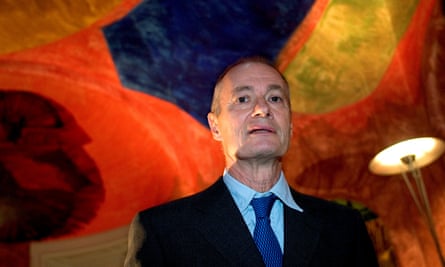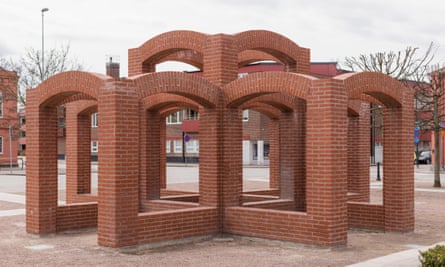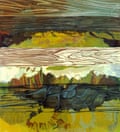Per Kirkeby, who has died aged 79, was one of the great experimenters of the so-called neo-expressionist style of painting. Alongside artists including Georg Baselitz and AR Penck, he rejected conceptualism, reviving a more emotional, instinctive approach to the canvas. “I’m a painter and have painted a painting,” he said. “And really, I don’t want to say anything more about it.”
Yet the celebrated Danish artist, who had a 2009 retrospective at Tate Modern, also turned his hand to so much more in a career that spanned five decades, producing sculpture, architecture, films, poetry, art criticism, travel writing, ballet sets and theatrical costumes. Kirkeby’s first love, however, was geology, the discipline that informed much of this polymathic output.
His oil paintings are notable for their muddy colours. A series of untitled canvases from the 1980s are typical. In one, from 1980, three metres by two, swirls of mossy greens are consumed by swathes of earthy browns. Streaks of yellow glint through. Tangles of thick brown strokes frame the composition.

Kirkeby’s canvases retained their organic palette throughout his career, his work oscillating between outright abstraction and landscape painting, often within a single composition. His Wald-Variation (Forest–Variation) series from 1989 is rich with gestural green and blue brushstrokes, for example, yet at various points the outline of a tree or boulder, painted in black, is clear. Likewise Kirkeby’s bronze sculptures, which he made from 1981 onwards, are both abstract lumps and representations of the rocks that he studied on the field trips he made throughout his life.
Per was born in Copenhagen to Alfred Kirkeby Christensen, an engineer and admirer of Tito, and Lucy Bertelsen, an avowed communist. As a teenager, he was sent on trips to Moscow, Berlin and Warsaw as part of a communist youth group. At Grundtvigskolen high school in a working-class area of Copenhagen, Per, who was dyslexic, gravitated to art. But on attending the Vestre Borgerdyd Gymnasium, he recalled struggling with drawing in art class, leading him to take geology at the University of Copenhagen instead.

There, however, he refined his sketching skills during several field trips to Greenland, first to Narssaq in 1958 and then to the west coast in 1960. On one such trip Kirkeby and a colleague were confronted by a polar bear. Fearing for their lives, the animal was shot, through its left eye – “the only way you can kill a polar bear,” Kirkeby would later claim.
In 1962, while at university, Kirkeby approached Poul Gernes, a leading light in Danish conceptualism and asked if he might join Gernes’s experimental school. Kirkeby had the naive idea that Gernes could teach him etching. Gernes agreed he would mentor the 24-year-old but at their first meeting took a copper sheet and smashed it with a hammer. “Here,” the older artist said, handing back the crumpled metal. “This is etching.”
Hypnotised, Kirkeby embraced the avant-garde fluxus movement. By the time he graduated from university in 1964, having written his dissertation on the geological mapping of the southern Peary Land peninsula, Greenland, over the last 2.6m years, the quaternary period, he had already travelled to Düsseldorf, on Gernes’s encouragement, to take part in a sound work, Siberian Symphony, by Joseph Beuys.

With an artist’s grant from the Danish government, the early 60s was a time of rampant experimentation for Kirkeby. While continuing his geological work – in 1965 he went to Greenland again, on a meteorite expedition to Melville Bay – he published three collections of poetry, a novel and a book of essays (notwithstanding his dyslexia), participated in various happenings and, in 1967, travelled to New York with the Korean-American artist Nam June Paik, a figure credited as the founder of video art. Influenced by Andy Warhol, Kirkeby produced his first short film in 1968, a portrait of Brigitte Bardot.
His painting at the time was similarly influenced by pop art, if prosaically so, using household emulsion and collaged fragments of magazines on hardboard. His first exhibition, in the annex of the Den Frie artist’s association in Copenhagen in 1964, included Car Pictures, a single work over four panels.
If the 60s saw Kirkeby in step with the prevailing artistic fashions, in the following decade he fell out with Gernes and embraced painting and its history, establishing his own neo-expressionistic style, loosely associated with the German painting scene that included Baselitz, Penck, Markus Lüpertz and Jörg Immendorff.
“As I picked up a tube and carefully squeezed a little oil paint on to the palette” he recalled. “I felt a huge burden of history weighing down on my shoulders.” The German artists were represented by the gallerist Michael Werner, who visited Kirkeby’s studio in 1974. Kirkeby had his first exhibition at Werner’s Cologne space the same year.

In 1976 he represented Denmark at the Venice Biennale (and returned to exhibit three further times, in 1980, 1993 and 1997), and took part in two editions of the quinquennial Documenta, in Kassel, Germany, in 1982 and 1992. In 1985 Nicholas Serota gave him a solo show at the Whitechapel Gallery in London and, again under Serota’s patronage, Kirkeby had a retrospective at Tate Modern in 2009.
Yet, still, a single medium could never satisfy him. In 1973 Kirkeby exhibited his first large-scale brick sculpture, in Ikast, Jutland, a work that combined quintessential Danish red brick with Mayan architectural design, inspired by a trip to Mexico, Honduras and Guatemala two years earlier. His public brickworks, which he referred to as “buildings without purpose”, can be found across Europe, including outside the German National Library, in Frankfurt, and the DR Byen station in Copenhagen, and as a series of five interconnecting arches and windows built on a grassy slope overlooking a fjord in the Norwegian county of Nordland. Not all the brick projects rejected utilitarianism however: in 1997 and 2000 he built bus shelters in the German towns of Munster and Neuss.
In 2000 Kirkeby was commissioned to make eight rock-like bronze sculptures for the Bundesrat, Germany’s upper house, in Berlin, and in 2005 he installed four bronzes at Copenhagen’s newly opened opera house. He painted murals for the rotunda of the Geological Museum, Copenhagen, and the Royal Danish Library, and on the ceiling of the auditorium at Aarhus University.
Kirkeby enjoyed a long friendship with the film director Lars von Trier, and created title cards for Breaking the Waves (1996), Dancer in the Dark (2000) and Antichrist (2009). In 1999 he turned his hand to scenography and costume, creating designs for New York City Ballet’s production of Swan Lake. “I always thought that an artist should not be easy to ‘catch’, to ‘put in a box’,” he said in an interview in 2009.
In 2013 Kirkeby fell down a flight of stairs at his home in Copenhagen, hitting his head and suffering brain injury. As documented in the 2015 film Man Falling by Anne Wivel, the accident affected his memory and, often not recognising his own work, he did not paint again.
He is survived by his third wife, Mari Anne Duus Jørgensen, whom he married in 2005, and four children: Sophus and Absalon, from his marriage to the film producer Vibeke Windeløv; Rebecca, from his marriage to Elisabeth Therkildsen; and Charlotte, from another relationship. His first two marriages ended in divorce.

Comments (…)
Sign in or create your Guardian account to join the discussion